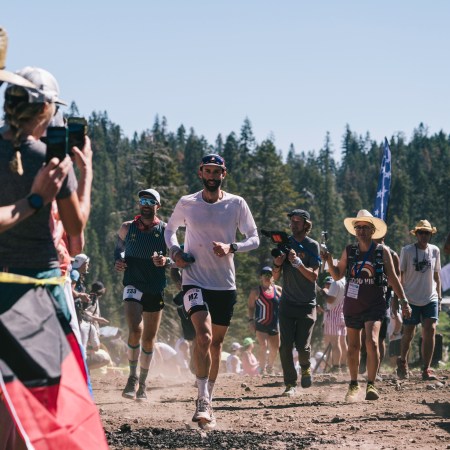On a muggy Monday morning in East Hampton this past August, Nev Schulman ran six miles in 43 minutes. Racing along Abrahams Path, a shaded road that winds past golf courses and squash stands, Schulman split sub-6:30 for his third, fourth and fifth miles. That pace would be impressive for a long-distance runner at any age; for a man one month removed from 40, it telegraphed some serious fitness.
Sunburnt in a singlet, Schulman took a selfie with the Hook Windmill and uploaded the activity to Strava. He captioned the post: “Made the top 1% of this route EVER!”
Training was going well. Schulman is based in Brooklyn, and he’d come out to Long Island with his wife and three kids to stay at his dad’s house for the rest of an oppressively hot summer. It was an opportunity to get some miles in. For nearly a decade, the TV star had built up his running life — finishing one New York City Marathon after another, cementing a personal best of 2:58, trying his hand at different distances in different cities. A half-marathon was on the horizon, and this time, he hoped to set a new personal best.
Life Can Change in an Instant
Later that afternoon, Schulman boarded his e-bike and set off to pick up his son from day camp. It was a familiar route, but the Hamptons’ roads are at their busiest and least predictable in the summer, and its smaller arteries are typically without sidewalks or bike lanes. Coming up on traffic near Town Pond, navigating the end of a shoulder into a right turn, Schulman ran out of pavement.
“I’m not sure exactly what happened, ’cause I don’t remember,” Schulman told me this week. “But somehow, traffic didn’t move how I thought it would, and I ended up getting into an accident where I flew over my handlebars and hit the back of a work truck. And I don’t…all I remember was this moment where I realized I needed to slow down, but I didn’t have time to do that, and I just remember thinking, like, ‘Oh no.’ The next thing I remember was my shirt getting cut off by the paramedics as they loaded me into the ambulance.”
Paramedics found Schulman on the ground, face up. When he regained consciousness — 10 minutes after impact is his best guess — his hands were really hurting, despite the fact that he hadn’t broken any fingers or even cut up his skin. It was a red alarm to first responders that he might’ve sustained nerve damage to his spinal cord. At Stony Brook Southampton Hospital, medical personnel took X-rays of his skull and a CAT scan of his spine. Thanks to his helmet, Schulman had no head trauma. But they discovered stable fractures in two vertebrae of his cervical spine, C5 and C6.
In simpler terms: he’d broken his neck.
The next thing I remember was my shirt getting cut off by the paramedics as they loaded me into the ambulance.
– Nev Schulman
He was transferred to Stony Brook University Hospital, about 90 minutes west, arriving there late Monday night, and on Tuesday morning, he was the very first emergency surgery of the day. The surgeon, Dr. Harry Mushlin, performed a laminectomy, which essentially involved trimming down the bony arch at the top of Schulman’s spine, with the intention of relieving pressure on the fractures, and by extension, the rest of the spinal cord. This sort of surgery, while a last-resort operation, has a high success rate.
It certainly went well for Schulman — the pain in his hands reduced, and so did the terror of potential paralysis, as all the while he retained feeling in all of his limbs and extremities. But no one could have predicted how quickly he healed.
“New doctors and nurses come in every six or 12 hours, and each time they’d come in, having seen my chart, knowing that I was in a bike accident, had fractured my C5-C6, they all couldn’t believe that I was mobile,” he said. “And that by the second day, I was asking to get up out of bed and go to the bathroom. They couldn’t believe it. They were really delighted to see that I had narrowly escaped almost certain paralysis of some kind. It was pretty remarkable. I spent six days in the ICU, then I came home and I wore a brace for five additional weeks.”
Five days after the accident, Schulman posted a series of images to Instagram: radiographs of his neck charting an unnatural dog-leg right, a purple gash below his hairline, some of his first rickety steps from the hospital bed, and somehow just as unsettling as all the above, a screenshot of a voicemail transcription, clearly left by the counselor at his son’s day camp: “I was just curious if somebody was on their way for Cy. Pickup time is at 2:35. If you can just reach out to his teacher, give us a call back…”
Sometimes, there never is a call back. In 2022, there were over 1,000 cyclist deaths in the United States that involved crashes with motor vehicles — the highest number ever recorded. Schulman reflected on his narrow survival in his Instagram post, sharing that the day before, he had gone fishing with his family.
“One of those days that just work…. It was magical,” he wrote. “A day full of love and wonder in the way only calm days in nature with family can be. Monday was not a day like that. Monday was a day where I learned what ‘before the accident’ really means. And Monday gave weight to just how lucky I was to have Sunday. It’s true what they say — life can change in an instant.”

Catching the Bug
Before Schulman found fame for his 2010 documentary Catfish, and a steady day job as the host and executive producer of the film’s spin-off reality series, Catfish: The TV Show, he was a city kid with a dad who liked to run. “He was always going out,” Schulman recalled. “Every morning.”
Robert A. Schulman’s apartment was near Tavern on the Green, the heritage American restaurant on Central Park’s West Drive, which marks the unofficial finish line of the NYC Marathon. “Every Marathon Sunday, he would take me and my brother, when it was obviously a little bit more casual, and we would just walk and find a spot on the grandstands and we’d watch the finishers cross. He would always use it as an opportunity to tell us the story of his sub-three-hour marathon and how much he loved training for that.”
If You Want to Run a Company, Run a Marathon
Meet Greg Ho, the investment exec who plans to run 100 marathons by 100Schulman didn’t grow up running — or playing competitive sports at all, aside from games at his summer camp in Maine, which he remembers as “just a bunch of sweet, pudgy Jewish boys from the city of New York playing lacrosse, tennis, basketball and soccer.” But he always had a competitive spirit, and when a friend invited him to participate in a sprint triathlon in 2015, he gave it a go. Schulman confesses the race was “pretty terrible,” but the experience reminded him that adults were allowed to compete in things, while sparking nostalgia for the years his dad had spent running.
The following year, Schulman ran a 3:22 in his first marathon in New York, “with no understanding of the commitment that it takes to run a sub-three at the time.” But he kept at it. He loved the trackability of it all. “I could actually watch myself get stronger, see my times go down, finish an exercise that was nearly impossible two months ago and it now felt easy.” By 2018, he knew exactly what he was doing, notching his PR of 2:58:54.
Still, it took all he had. Towards the end of the race, Schulman said, “The world got really dark on the edges and I’m just like, keep going. Just keep going.” His running coach, Roberto Mandje of New York Road Runners, the group that produces the TCS NYC Marathon, paced him for the majority of the race, until ducking out to go to the bathroom on 5th Avenue near 110th Street, around mile 23.
“He said, ‘Keep going, I’ll catch up.’ But after like three or four minutes, I’m like, if he hasn’t caught up with me by now, I don’t think he’s catching up. It turns out he had been holding out as long as he could with a terrible sprained ankle or something, and he didn’t wanna freak me out and he didn’t wanna get in my head. So he just told me he had to go to the bathroom, but he totally bonked. He couldn’t finish. He was sending me off in the hopes that I held on. And I did. Luckily I did.”
After that race, Schulman faced a bizarre conundrum that is unique to the sub-elite marathoning set, and especially for those who’ve eked past the three-hour mark: What now? He could train just as hard the next year, and possibly shave off a couple more minutes. But was it worth the physical — and mental — effort? Schulman opted against it. “Setting a faster goal felt insane,” he said. “I don’t need to go faster than that. I decided I’ll just run it for fun and raise money for New York Road Runners Team for Kids.”

Aboard with Achilles International
Schulman kept at this for years — he’s now run the New York City Marathon five times — until last year, at which point he found himself searching for meaning in the marathon again.
“Not to say that New York Road Runners Team for Kids isn’t a great organization to support, but I didn’t have a personal connection for me,” he said. “I just didn’t feel like I was engaging with the potential of the event enough, and that I was just doing it for my own purposes.
“I was thinking, how can I make it feel more meaningful? And it dawned on me. I always see the Achilles athletes every year. I’m always so impressed and in awe of them. Maybe I could do that. So, I reached out to Achilles and asked if they still needed any guides for the marathon, and the only person who still needed a guide was Francesco [Magisano] because he’s actually the director of the New York chapter of Achilles. He had assigned guides to everyone else before himself.”
Founded in 1983, Achilles International has 110 chapters across the globe and 40 in the United States. The first Sunday in November is its biggest day of the year, as hundreds of its athletes and guides run the New York City Marathon in tandem. These runners have a variety of disabilities and conditions: cerebral palsy, autism, traumatic head injuries, rare immune diseases, above-knee amputations. Francesco Magisano is blind — and he’s also an elite para-triathlete and para-cyclist. He and Schulman hit it off.
“We went for a run in the park and immediately became friends. I mean, he’s hilarious. We got along right away,” Schulman said. “Ran the race [in 2023], had the best time. And then immediately — I mean it couldn’t have been more than a week or two later — he invited me to run Boston Marathon with him, which we did in April, and also had the best time.”

The Road to Recovery
Two weeks after Schulman’s accident in August, he started responding to text messages from those in his network, processing “all the things that were now changed for the fall.” The trips that couldn’t happen, the things he wouldn’t be able to do — the marathon included. He’d broken his neck 12 weeks before the New York City Marathon; that’s typically the duration (or up to a month more) that runners need to get in shape for the race. His participation seemed firmly out of the question.
He owed Magisano the benefit of time, in order to find a new guide. Even with all the connections in the world, approving guides and generating bibs is a process — and that’s to say nothing of the training the new guide would have to take on. But Magisano, to Schulman’s surprise, was unfazed.
“He was like, ‘Nev, it’s okay. Don’t worry about it. Let’s just see how you feel in a couple weeks, ’cause I’d still love to have you as my guide and I don’t care how fast or slow we go, I want you there,’” Schulman remembered. “[So I’m thinking] okay, maybe I could walk or jog with him. And that would be an amazing story and an opportunity to get back on my feet.”
Dr. Mushlin had asked Schulman to wear the neck brace for six weeks, and he obliged. But those propitious early days in the hospital carried through August; Schulman’s neck healed quickly and well. By the time he was allowed to take the brace off, X-rays showed there was no reason he couldn’t return to activity. “I was so excited,” Schulman said. “I asked, ‘Can I run?’ And Dr. Mushlin said, ‘Your neck is healed, so as long as you feel comfortable and it doesn’t bother you, do whatever you want.’ So I went for that first jog. It felt great, and I just slowly added miles and increased my pace.”
Schulman texted Magisano again to update him on his progress. “I was like, okay, I’m feeling pretty good. I’m definitely running again. I’m going slow, but what’s your pace looking like? He told me his hope was to finish somewhere around a four-hour marathon, which I’m comfortable with. I know that I can do that without an aggressive training program, just with my base-level fitness. I’d been training aggressively before [the accident]. And now I’m back on my feet, running 7:30s again.”
Six Feet at a Time
Laying in a hospital bed for six days, Schulman felt lucky to still be alive. And over the following weeks, he came to appreciate just how much he relied on his running life. Immobility and muscle fatigue reigned supreme throughout his recovery, and the time off drove him crazy. I asked him what running means to his mental health.
“My whole life, I’ve always wished I were fitter and stronger,” he said. “I’ve admired the bodies of people who are bigger and more defined than I. But I’ve accepted that, while I could do those things, it’s just not my default. When I discovered running, I just realized this is it. This is the thing that I love doing, that gets me moving. And I’ll do it for hours. I’m happy to do it. Put me in the gym for 15 minutes and I’ll be distracted and I’ll probably be bored, but an hour-and-a-half run? Great.”
Over those six weeks of recovery, Schulman noticed that his ability to manage his stress and frustration was way down. Like so many other runners, he depends on the activity to quiet the voices in his brain, to harness the present.
“It’s the form of meditation that I can do. When I’m running, I’m just focused on my breathing. Sometimes I’ll get the chorus of a song in my head. I’ll just kind of sing it…or I don’t know if I’m actually singing it, or if it’s just singing in my head. But it just repeats. I’ve thought about this in the past, how it’s very much like a mantra. I don’t have one that I use all the time, but it’ll pop in and I’ll go over it and match it to my rhythm of running, and all I’m thinking about is my breathing and the six feet in front of me. My whole world shrinks. The outside noise and concerns and worries don’t exist.”
Runners recognize this: life is a gift, and so too is the running life, the box within the box, the slog that sharpens, the lucky ritual that puts the world on pause. This Sunday, with his family waiting to hug him and his friend running by his side, a grateful Schulman gets to run the marathon for the sixth time, six feet at a time.
Whether you’re looking to get into shape, or just get out of a funk, The Charge has got you covered. Sign up for our new wellness newsletter today.

























